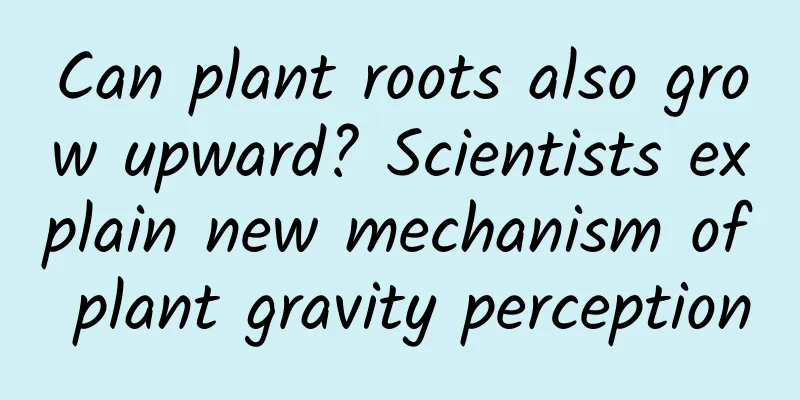Can plant roots also grow upward? Scientists explain new mechanism of plant gravity perception

|
Produced by: Science Popularization China Author: Li Yin (School of Life Sciences, Sun Yat-sen University) Producer: China Science Expo Organisms evolved under the influence of gravity, and plants can sense the direction of gravity and thus adjust the morphology and growth state of the aboveground parts and roots. Gravitropism is one of the most important processes for plants to adapt to the terrestrial environment. The above-ground part of the plant grows upward, while the roots keep drilling into the soil. The roots grow in the direction of gravity, and even if they are not placed vertically or even in a flat state, they can bend and grow in the direction of gravity. Rapeseed seedlings bend toward gravity (compared to the photo when they were lying flat at the beginning) (Image source: Reference [1]) So how did all this happen? Balance Cell: My function is to sense gravity The geotropism of the root system is a very complex physiological process. What is known is that the root system's perception of the direction of gravity comes from specialized cells called " balance cells " in the root cap's pith cells. These cells contain starch bodies called "statoliths," which are deposited or moved in sensitive areas of the root tip, playing a role in balancing and guiding growth. Statoliths can be freely suspended in cells, and when the plant is in a vertical position, the statoliths will be deposited at the bottom of the root tip. The distribution of starch particles in the root tips of vertically grown Arabidopsis seedlings after germination for 7 days, stained with iodine and fluorescent staining (Image source: Reference [7]) When the plant root system tilts, the balance stone moves to the bottom of the cell due to gravity deposition. The change in its position will generate a signal that is transmitted to the plant cells, allowing the plant to readjust its growth direction and maintain vertical growth. Therefore, the starch granules, as statoliths, play a key role in root growth and gravity perception, and thus adapt to changes in the environment. The movement of starch granules in the statoliths leads to signal changes in the directional flow of the plant hormone auxin. Auxin plays a central role in mediating root gravitropism and can promote gravity perception, but the specific molecular mechanisms are still largely unknown. Schematic diagram of gravity sensing in root cap cells. The start time of the vertical growth state of the root is set to 0 minutes, the seedling is rotated 90 degrees to reorient and the timing is started. The diagram shows the time course of gravity stimulation and the initiation of gravity sensing. (Image source: Reference [5]) Polar transport and gravitropism of auxin in dicot seedlings. The direction of auxin transport is indicated by the arrows, whose thickness indicates the amount of auxin transported in the corresponding stream. (Image source: Reference [6]) Amylosome: I am not a force carrier For a long time, the gravity sensing mechanism has been speculated to be a mechanical sensing process in which the starch body transmits force to intracellular structures . This is the mechanotransduction model , but the relevant molecular mechanism has not been proven. Subsequent studies proposed another speculation, namely the position sensor model, which holds that the starch body approaches or touches the plasma membrane, inducing local auxin flow in the cell at the contact site, and the sum of these local flows determines the direction of the total auxin flow. Two models of gravity signal transduction in amyloplasts: the mechanotransduction model (a, b), in the steady state (a), amyloplasts do not trigger signaling by squeezing actin filaments; once amyloplasts move in response to gravity (b), they provide mechanical tension on actin filaments to activate signaling pathways. The position sensor model (c, d), proximity or contact sites between amyloplasts and the plasma membrane induce localized auxin flow in the cell, as indicated by arrows. (Image source: Reference [2]) Previously, scientists discovered a LAZY1 (lazy) protein gene in rice. When this gene mutated, the rice showed a phenotype of creeping stem growth, like a lazy bug that couldn't get up. Studies have confirmed that the LAZY1 protein is closely related to the perception of gravity direction in rice stems. Subsequent studies have found that the transduction of starch deposition signals in plant cells depends on members of this protein family (collectively referred to as LAZY1-LIKE proteins, abbreviated LZY), but the connection between LZY proteins and the redirection process of auxin transport has not yet been fully resolved. Schematic diagram of the polar auxin transport in the primary root tip and gravity signaling in root cap cells during redirection. (Image source: Reference [3]) A study published in Science in August 2003 solved the mystery, demonstrating that the LZY protein family is involved in gravity signal transduction in plant root amyloplasts and related plasma membranes, resulting in polar positioning according to the direction of gravity. The study found that all LZY proteins in Arabidopsis have more than two highly alkaline hydrophobic domains in their amino acid sequences, which are usually associated with membrane binding. If the genes of these proteins are mutated, the primary roots of the mutant plants cannot sense the direction of gravity, resulting in a strange phenomenon of growing upward instead of drilling underground. By restoring the expression of LZY proteins through transgenics, the plants can return to normal, proving that the localization of LZY proteins on the plasma membrane is necessary for their function in gravity signals. 5-day-old wild-type and LZY mutant Arabidopsis seedlings (Image source: Reference [4]) Experimental observations found that under the stimulation of gravity, the starch granules moved, and the LZY protein also moved to a new plasma membrane position in the direction of gravity, producing a new polar distribution. In a mutant plant lacking starch, the starch granules were basically unable to deposit in the direction of gravity, and the LZY protein could not produce polarity on the new plasma membrane. Scientists have thus proved that the polarization of LZY protein on the plasma membrane is caused by the deposition of starch particles . By performing optical tweezers on the movement of starch particles, the optical tweezers cause the starch particles to move in position (optical tweezers are a technology that won the 2018 Nobel Prize in Physics, which uses the radiation pressure generated by lasers to perform contactless manipulation of the movement of tiny particles). It was observed that LZY protein can bind to amyloid and accumulate on the plasma membrane near the concentrated area of amyloid, and this process does not require the participation of gravity. Therefore, the distribution of LZY protein is determined by the location of amyloid, not by gravity. The animated image shows the fluorescence of the fluorescently labeled LZY protein (left) and the starch bodies visible under bright field (right). From the change in fluorescence density, it can be seen that the LZY protein responds to the starch bodies manipulated by optical tweezers, moves accordingly, and aggregates to the plasma membrane where the starch bodies are concentrated. (Image source: Reference [4]) The results of the study proposed a gravity sensing mechanism in which LZY proteins indicate the direction of gravity by transmitting information about the location of amyloid. LZY proteins on the plasma membrane are able to move, and when the direction of gravity changes, LZY proteins can bind to amyloid, relocate to the site where amyloid is deposited, and then move to a new site on the plasma membrane to generate polarity. The study also found that the LZY protein on the plasma membrane needs to bind to a protein called RLD in the cell to form an interacting molecular partner. The two jointly regulate the transport of auxin, most likely by transmitting information about the direction of gravity through membrane transport, thereby affecting the transport of auxin and changes in plant growth. Model of subcellular localization change of LZY protein under gravity stimulation dependent on starch body deposition (A) and model of polar localization of LZY protein on plasma membrane dependent on starch body deposition initiating gravity signal transduction (B) (Image source: Reference [4]) The significance of this discovery is that it clarifies that the polarity of LZY protein in the plasma membrane is not achieved by gravity, but by the movement of the starch body, that is, by position sensing rather than mechanical force. This shows that the long-held assumption that plants sense gravity by "exerting forces on the internal structure of cells through balance stones" is incorrect. This discovery strongly supports the position sensor hypothesis and provides an extremely important theoretical basis for future exploration of the molecular mechanism of plant polar transport. Conclusion Although scientists have figured out how plants sense gravity, we still have a long way to go in exploring the molecular mechanism of plant gravity signal transmission. In fact, in addition to geotropism, plant roots also have multiple characteristics such as fertility and hydrotropism. The roots will actively grow towards the soil that is rich in water and nutrients. It is these "smart" characteristics of plant roots that allow plant life to grow well and be protected, thereby maintaining the needs of growth, development and reproduction. References: [1] Ajala C and Hasenstein K H. Plant Science, 2019, 285: 214–223. [2] Kawamoto N and Morita M T. New Phytologist, 2022, 236: 1637–1654. [3] Nakamura M, et al. Journal of Experimental Botany, 2019, 70(14): 3495–3506. [4] Nishimura T, et al. Science, 2023,10.1126/science.adh9978. [5] Singh M, et al. Frontiers in Plant Science, 2017, 8:1304. [6] Stanga J, et al. Signaling in Plant Gravitropism. In: Signaling in Plants. Springer, Berlin, Heidelberg. 2009, pp209-237. [7] Zhang Y, et al. New Phytologist, 2019, 224: 761–774. |
<<: How did Leonardo da Vinci use the Mona Lisa to "cheat" you?
Recommend
Google Photos now supports Apple's Live Photos feature
In the latest iOS version update, Google Photos h...
Pinduoduo’s method of improving user conversion rate!
Pinduoduo, an e-commerce company, achieved revenu...
How much does it cost to develop a supplement mini program in Meishan?
How much does it cost to be an agent for a supple...
The real mask of fake "upturned buttocks" - pelvic tilt (Part 2)
In the last issue, we shared how to judge pelvic ...
Postpartum transformation training camp, 15 minutes a day for 30 days, let the beautiful mother glow with girlishness
Postpartum transformation training camp, 15 minut...
Birds are masters of architecture, and they are also very cunning in their quest for mates.
Excellent architecture is not exclusive to humans...
Let’s talk about the process of the project from 0 to 1
As the saying goes, there are more projects and m...
Galaxy Note4's four tricks
Samsung's new generation of giant screen flags...
If there is a lot of foam in the urine, does it really mean that my kidneys are not in good condition?
gossip "Excessive foam in urine indicates ki...
Extinct duck species
Geese and ducks are almost one of the most famili...
A Complete Guide to Business Analysis - Using Data Analysis to Solve Business Problems
A Complete Guide to Business Analysis - Using Dat...
Aiti Tribe Stories (30): My Love-Hate Relationship with Python
[51CTO.com original article] Taniey's relatio...
#千万IP创科普# During the National Day holiday, please keep this highway driving safety guide
During the National Day holiday, free passage wil...
"Moore's Law" is coming to an end. Will photonic chips become the future of the electronics industry?
"The number of transistors integrated into a...
AMOLED vs. IPS: What are the differences between the two screen materials?
When it comes to smartphones and tablets, the scr...









